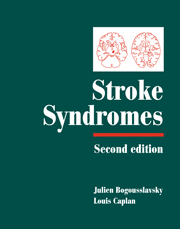Book contents
- Frontmatter
- Contents
- List of contributors
- Preface
- PART I CLINICAL MANIFESTATIONS
- 1 Stroke onset and courses
- 2 Clinical types of transient ischemic attacks
- 3 Hemiparesis and other types of motor weakness
- 4 Sensory abnormality
- 5 Cerebellar ataxia
- 6 Headache: stroke symptoms and signs
- 7 Eye movement abnormalities
- 8 Cerebral visual dysfunction
- 9 Visual symptoms (eye)
- 10 Vestibular syndromes and vertigo
- 11 Auditory disorders in stroke
- 12 Abnormal movements
- 13 Seizures and stroke
- 14 Disturbances of consciousness and sleep–wake functions
- 15 Aphasia and stroke
- 16 Agitation and delirium
- 17 Frontal lobe stroke syndromes
- 18 Memory loss
- 19 Neurobehavioural aspects of deep hemisphere stroke
- 20 Right hemisphere syndromes
- 21 Poststroke dementia
- 22 Disorders of mood behaviour
- 23 Agnosias, apraxias and callosal disconnection syndromes
- 24 Muscle, peripheral nerve and autonomic changes
- 25 Dysarthria
- 26 Dysphagia and aspiration syndromes
- 27 Respiratory dysfunction
- 28 Clinical aspects and correlates of stroke recovery
- PART II VASCULAR TOPOGRAPHIC SYNDROMES
- Index
- Plate section
8 - Cerebral visual dysfunction
from PART I - CLINICAL MANIFESTATIONS
Published online by Cambridge University Press: 17 May 2010
- Frontmatter
- Contents
- List of contributors
- Preface
- PART I CLINICAL MANIFESTATIONS
- 1 Stroke onset and courses
- 2 Clinical types of transient ischemic attacks
- 3 Hemiparesis and other types of motor weakness
- 4 Sensory abnormality
- 5 Cerebellar ataxia
- 6 Headache: stroke symptoms and signs
- 7 Eye movement abnormalities
- 8 Cerebral visual dysfunction
- 9 Visual symptoms (eye)
- 10 Vestibular syndromes and vertigo
- 11 Auditory disorders in stroke
- 12 Abnormal movements
- 13 Seizures and stroke
- 14 Disturbances of consciousness and sleep–wake functions
- 15 Aphasia and stroke
- 16 Agitation and delirium
- 17 Frontal lobe stroke syndromes
- 18 Memory loss
- 19 Neurobehavioural aspects of deep hemisphere stroke
- 20 Right hemisphere syndromes
- 21 Poststroke dementia
- 22 Disorders of mood behaviour
- 23 Agnosias, apraxias and callosal disconnection syndromes
- 24 Muscle, peripheral nerve and autonomic changes
- 25 Dysarthria
- 26 Dysphagia and aspiration syndromes
- 27 Respiratory dysfunction
- 28 Clinical aspects and correlates of stroke recovery
- PART II VASCULAR TOPOGRAPHIC SYNDROMES
- Index
- Plate section
Summary
Anatomy, physiology and blood supply
Axons of the retinal ganglion cells project through the optic nerves, chiasm and tracts. Each optic tract carries visual information from the contralateral hemifield of both eyes, projecting mainly to the lateral geniculate nucleus. Smaller projections subserving the pupillary light reflex exit just prior to the termination of the tract, heading to the pretectal nuclei, and there are minor projections to hypothalamic circadian nuclei and brainstem ocular motor structures. The tract lies ventral to the brain, coursing just dorsal to the hippocampus. The fibres from the two eyes are not well aligned initially, but the correspondence improves gradually along the course of the tract. The retinotopic map also becomes tilted, so that the macula is represented dorsally, superior quadrant laterally, and inferior quadrant medially (Hoyt & Luis, 1963). The optic tract is supplied by branches of the anterior choroidal artery, which originates from the supraclinoid segment of the internal carotid artery. The anterior choroidal artery courses posterolaterally, at first inferior and lateral to the optic tract, and later on its medial side, giving penetrating branches to the optic tract and to the lateral geniculate nucleus.
The lateral geniculate nucleus contains the terminations of the optic tract fibres and the neurons which give rise to the optic radiations. It is not merely a relay nucleus, but receives inputs from visual cortex (Sillito & Murphy, 1988) and brainstem (Harting et al., 1991) that modulate its information transfer. It is a subnucleus in the ventro-posterolateral thalamus. Neighbouring subnuclei are the medial geniculate nucleus ventromedially, the ventral posterior nucleus dorsomedially, and the pulvinar dorsally. The acoustic radiations pass dorsomedially on their way to auditory cortex.
- Type
- Chapter
- Information
- Stroke Syndromes , pp. 87 - 110Publisher: Cambridge University PressPrint publication year: 2001
- 6
- Cited by



